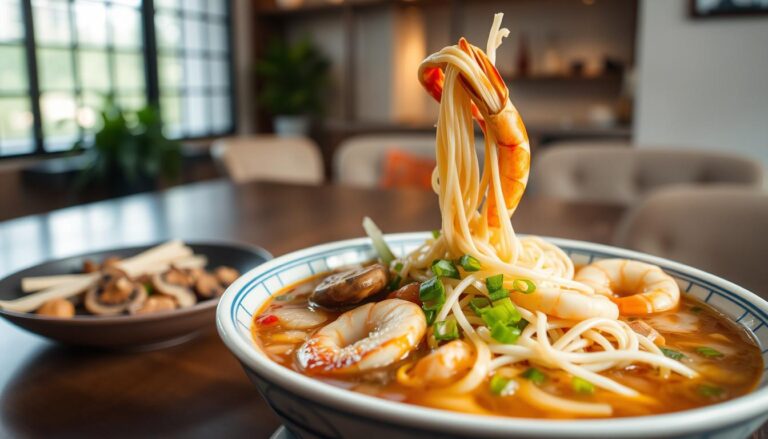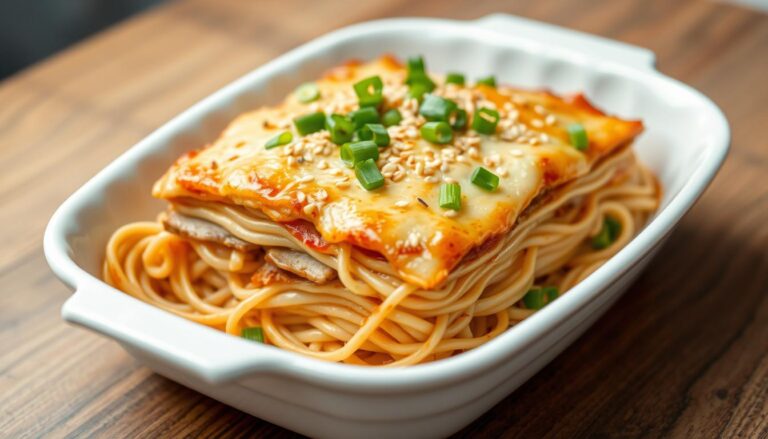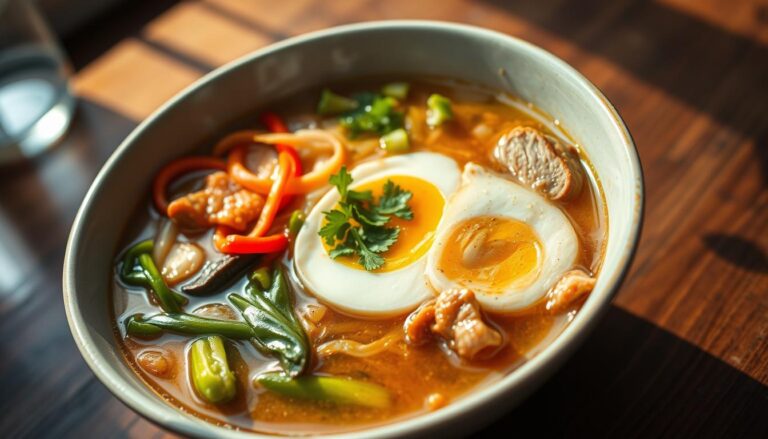Ramen Noodle Seasoning Recipe: Elevate Your Meals
Unlocking the secret to amazing ramen starts with a homemade seasoning recipe. This recipe turns simple noodles into a dish fit for a restaurant. Ramen in the US has grown from basic packets to a gourmet experience. Now, you can make this magic in your own kitchen.
My seasoning recipe is a game-changer for anyone wanting real flavors at home. With just a few ingredients, you’ll make a blend that adds depth and excitement to noodles. It’s easy to make and packs a punch.
The secret to great homemade seasoning is mixing Asian flavors with easy-to-find ingredients. Each sprinkle adds layers of taste, from savory to spicy. It turns your meals into a gourmet journey.
Whether you’re a college student or a home chef, this seasoning is your secret ingredient. I’ll show you how to make a versatile blend that’s perfect for noodles, rice, and more. It’s your ticket to exploring Asian cuisine.
Get ready to discover flavors that will make your taste buds sing. This seasoning will take your cooking to new heights. Your journey to authentic, delicious ramen begins here.
Understanding the Art of Ramen Seasoning
Ramen has grown from a quick meal to a beloved art form in the U.S. Its journey shows a deep cultural story, beyond just flavor packets.
Ramen’s fame worldwide comes from its rich flavors and cultural value. An authentic spice blend is more than taste. It opens doors to Japanese cooking traditions.
History of Ramen Seasonings
Ramen seasonings started with Japanese cooking methods. Chefs mixed:
- Umami-rich ingredients
- Subtle spice combinations
- Carefully selected dried herbs
Evolution from Instant to Gourmet
Ramen’s change in the U.S. is amazing. It went from cheap instant noodles to fancy restaurant dishes. Traditional seasoning was key.
| Era | Ramen Characteristics | Seasoning Complexity |
|---|---|---|
| 1970s | Instant Packet Meals | Low |
| 1990s | College Staple Food | Basic |
| 2010s | Gourmet Restaurant Dish | High |
Cultural Significance in Modern Cuisine
Today, making the right ramen spice is a craft. Both home cooks and chefs value the balance of flavors. It brings Japanese traditions to life.
The art of ramen seasoning keeps growing. It connects cultures through a flavorful dish.
Essential Ingredients for Perfect Ramen Seasoning
Making your own ramen seasoning is an art. It starts with knowing the right ingredients. Your simple seasoning can turn a basic meal into a feast. Let’s explore the key ingredients for a standout seasoning blend.

Base Ingredients and Their Roles
The heart of any great ramen seasoning is in its core ingredients. Here’s a look at the essential players that add depth and character:
- Chicken Bouillon Powder: 1/4 cup – Creates a savory base
- Garlic Powder: 8 tsp – Adds an aromatic punch
- Onion Powder: 4 tsp – Provides subtle sweetness
- Dried Parsley: 2 tsp – Brings fresh herbaceous notes
- Kosher Salt: 2 tsp – Enhances overall flavor profile
Umami-Rich Components
To elevate your ramen mix, add umami-rich ingredients. These boosters create a complex taste experience:
- Ground Dried Mushrooms: 1 tbsp – Introduces earthy richness
- Ground Cumin: 1 tsp – Adds warm, deep undertones
- Ground Ginger: 1 tsp – Brings bright, spicy complexity
Optional Flavor Enhancers
You can customize your seasoning with extra ingredients. Try these optional add-ins:
- Red Pepper Flakes: For heat lovers
- Dried Seaweed Flakes: For authentic Japanese flavor
- White Pepper: For subtle warmth
Creating a great ramen seasoning is all about balance. Start small and adjust to find your perfect mix.
Ramen Noodle Seasoning Recipe
Making the best ramen seasoning is simpler than you think. My quick ramen broth mix brings top-notch flavor to your kitchen with just a few ingredients. The key is to balance spices and create a mix that turns regular noodles into a special meal.

Now, let’s look at what you need for your perfect quick ramen broth mix. You’ll need:
- 1/4 cup chicken bouillon powder
- 8 tsp garlic powder
- 4 tsp onion powder
- 4 tsp dried parsley
- 2 tsp ground cumin
- 2 tsp ground ginger
- 2 tsp kosher salt
- 1 tsp black pepper
Mixing your best ramen seasoning is easy. Start by gathering all ingredients in a medium-sized bowl. Use a whisk to mix the spices well, making sure each one is spread evenly. This ensures every bite tastes the same.
Pro tip for your quick ramen broth mix: Keep the seasoning in an airtight container, away from sunlight and heat. When stored right, your homemade mix can last up to 3 months. It’s always ready to add flavor to your dishes.
This ramen seasoning recipe is very versatile. You can sprinkle it on noodles, use it as a marinade, or add it to other dishes for a flavor boost. Your homemade mix can turn simple meals into something amazing in seconds.
Creating the Perfect Flavor Balance
Making a flavorful noodle soup seasoning is like a fine art. It’s all about mixing different tastes to get that authentic Asian flavor. This turns a simple dish into a feast for the senses.

Salt and Umami Ratio
Finding the right balance of salt and umami is key. Think of seasoning as an orchestra. Each ingredient has its own role in creating harmony.
- Sea salt: 1-2 tsp for foundational flavor
- Dried kombu: 5g for deep umami undertones
- Bonito flakes: 3g to enhance savory depth
Spice Level Customization
Everyone likes their spice level different. Your noodle soup seasoning should let you adjust the heat. This way, you can enjoy it just how you like it.
| Spice Level | Chili Quantity | Flavor Profile |
|---|---|---|
| Mild | 1/4 tsp chili flakes | Gentle warmth |
| Medium | 1/2 tsp chili powder | Noticeable heat |
| Spicy | 1 tsp cayenne | Intense kick |
Aromatics Integration
Aromatics add life to your seasoning. Fresh ginger, garlic, and green onions can make it truly special.
- Ginger: 2 tsp, finely minced
- Garlic: 1 clove, crushed
- Green onions: 1 tbsp, thinly sliced
The secret to great seasoning is in the subtle layers. Start with small amounts and taste as you go. This way, you can fine-tune it to your liking.
Storage and Shelf Life Tips
Keeping your homemade ramen seasoning fresh is key. It’s a mix of spices and aromatics that needs care. This ensures its flavors stay vibrant and strong.
Here are my top tips for storing your homemade ramen seasoning:
- Choose an airtight container: Glass mason jars or sealed ceramic containers work perfectly
- Select a cool, dark pantry space away from direct sunlight and heat sources
- Keep humidity levels low to prevent clumping or flavor degradation
Your homemade ramen seasoning will stay fresh for about 6 months if stored right. I suggest labeling your container with the date you made it. This helps you keep track of how fresh it is.
Look out for these signs that your seasoning might be getting old:
- Loss of vibrant aroma
- Color changes in the seasoning blend
- Presence of moisture or clumping
- Unusual or stale smell
Pro tip: Freeze most of your homemade ramen seasoning in smaller portions. This can make it last longer and keep its flavor intense.
Creative Ways to Use Your Homemade Seasoning
Your ramen noodle seasoning recipe is a culinary powerhouse. It goes beyond just noodle dishes. I’ll show you how to turn simple meals into amazing ones with this quick ramen broth mix.
Versatility is key with homemade seasonings. Your ramen seasoning can make many dishes taste better with its deep, umami flavor.
Beyond Noodle Dishes
Ready to think outside the box with your quick ramen broth mix?
- Dry Rub for Meats: Sprinkle 1 tbsp per pound of protein for an instant flavor boost
- Popcorn Seasoning: Transform movie night with a savory sprinkle
- Roasted Vegetable Enhancer: Toss vegetables with the seasoning before roasting
Marinade Magic
Your ramen seasoning is a secret weapon in marinades. Mix it with olive oil, rice vinegar, and honey for a dynamic marinade. Use it for chicken, tofu, or seafood.
Flavor Boost for Other Recipes
Try your quick ramen broth mix in new places:
- Stir into scrambled eggs for a umami kick
- Mix with mayonnaise for a zesty dipping sauce
- Sprinkle over rice bowls for instant depth
- Blend into salad dressings for complex flavor
Every use shows how versatile your homemade ramen noodle seasoning recipe is. Don’t be shy to try new things and make each dish your own!
Health Benefits and Nutritional Considerations
Making your own ramen seasoning is more than just flavor. It’s a smart way to boost your nutrition. By picking the ingredients, you can turn a simple seasoning into a health powerhouse.
When making the best ramen seasoning, think about these nutrition tips:
- Use herbs and spices to cut down on sodium
- Add ingredients like nutritional yeast for extra nutrients
- Go for low-sodium versions of base ingredients
Homemade seasonings can offer big health benefits. Let’s look at the main advantages:
| Ingredient | Nutritional Benefit | Recommended Quantity |
|---|---|---|
| Nutritional Yeast | B-vitamin boost, protein source | 2 tablespoons |
| Dried Herbs | Antioxidant properties | 1 teaspoon mix |
| Turmeric | Anti-inflammatory properties | 1/2 teaspoon |
Your homemade ramen seasoning can be a health game-changer. By choosing the right ingredients and the right amounts, you make a flavorful mix that supports your health goals.
Common Mistakes to Avoid When Making Ramen Seasoning
Making an authentic ramen spice blend can be tricky, even for experienced cooks. The path to a flavorful noodle soup seasoning is filled with common mistakes. These mistakes can ruin your dish.
Here are the most critical mistakes to avoid when preparing your ramen seasoning:
- Overcomplicating the Flavor Profile
Don’t add every spice in your pantry. A good ramen spice blend is simple and balanced.
- Ignoring Salt Levels
Too much salt can ruin the umami of your seasoning. Measure salt carefully and taste as you go.
- Using Stale Ingredients
Spices lose flavor over time. Use fresh, high-quality ingredients for the best taste.
- Skipping the Taste Test
Always taste your seasoning before adding it. Making adjustments is key to perfect flavor.
Professional chefs see making ramen seasoning as an art. Focus on the details of each ingredient. Don’t be afraid to try new things within a safe range.
Start simple. Use basic ingredients like dried kombu, bonito flakes, and quality sea salt. Then, add complexity while keeping your seasoning authentic.
Conclusion
Making homemade ramen seasoning is more than just mixing spices. It’s an art that turns simple noodles into amazing dishes. Your seasoning recipe is like a flavor passport, letting you try new tastes at home.
The secret to great homemade ramen seasoning is finding the right balance and what you like. Each blend you make tells a story of your cooking skills and love for different cultures. By trying out different ingredients, you can make any noodle dish special.
Your adventure in making the perfect ramen seasoning is just starting. Begin with basic steps and grow your seasoning skills. Remember, every great recipe comes from being curious, practicing, and trying new flavors.
As you keep working on your seasoning recipe, see your kitchen as a place for creativity. It’s where old ways meet your own ideas. Always taste, adjust, and enjoy the tasty outcomes of your seasoning experiments.







